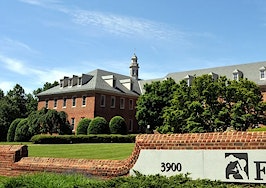- The Federal Reserve meets this week, and anticipation tends to freeze things.
- Nobody expects the Fed to hike this week, but the June meeting is under some consideration in markets.
- It’s a big world out there, but more interlocked financially than ever.
Financial markets are rattled, but maintaining the appearance of calm.
I should say the people in the markets are shaky, very much aware of unsustainable and fatal trends overseas, but their emotionless (and soulless) computers maintaining pretenses.
The Fed meets this week, and anticipation tends to freeze things. Long-term rates did rise last week, but a small thing, just bouncing up again from a repeated 10-year T-note low near 1.70 percent — the second bottom there this year, and fourth since 2013. Mortgages inched from 3.75 percent to 3.875 percent depending on the usual qualifiers.
Nobody expects the Fed to hike this week, but the June meeting is under some consideration in markets. Eric Rosengren, president of the Boston Fed, has since 2008 gotten my vote as best of the lot. In that August, he was the first to understand that a year’s frantic Fed easing had been more than offset by the shutdown of credit in markets. He has been skeptical of optimistic forecasts and reluctant to tighten.
So when Rosengren said the following this week, traders sold bonds, rates up:
“While I believe that gradual federal funds rate increases are absolutely appropriate, I do not see that the risks are so elevated, nor the outlook so pessimistic, as to justify the exceptionally shallow interest rate path currently reflected in financial futures markets.”
This line may have been no more than jawbone, leaning against market sentiment, but the Fed unquestionably intends to hike. Someday. Gradually.
Nor is there any question that the overseas panic after the Fed’s 0.25 percent hike in December was the reason the Fed stopped. Now those markets are calm. Their underlying economies are no better, or weaker, but the surface is calm and may invite the Fed to try it again.
Right here, shift to another thread and then tie it all together. The Fed’s initial quantitative easing (QE) in January 2009 saved us all. Rates came down, credit markets became liquid, and healing began. The Fed continued with QE2 and QE3, and stopped dead when the banking system began to generate credit on its own in 2013.
Foreign central banks are still at it, justifying continued QE as a benefit via “portfolio effect:” forcing investors from safe things into taking risk. That effect is hard to distinguish from inflating new bubbles. Once rates have been forced close to zero, QE is just monetizing debt, hosing cash into the global system in hopes that something good will result. Negative interest rates are also a portfolio policy, effectively charging a fee to investors holding safe assets, even cash.
Markets have quietly begun to dismiss the ongoing European Central Bank (ECB) and Bank of Japan exertions as a dead end, and maybe worse. Holding the euro and yen down, rates to zero, markets liquid, but doing nothing for healing and producing possibly dangerous distortions.
[Tweet “It’s a big world out there, but more interlocked #financially than ever.”]
It’s a big world out there, but more interlocked financially than ever. Try this chain of unintended QE consequence. The ECB has run out of government bonds to buy because they must be bought pro-rata to euro-nation GDPs (gross domestic products), and since the Germans have a balanced budget and issue no bonds, the ECB can’t buy any others, either. So the ECB is now turning its 80-billion-euro-per-month hose onto corporate bonds.
Interlocked world? When a foreign corporation borrows in the U.S. in dollars, the IOUs since the 1980s have been known as “Yankee bonds” (if in Japan, “samurais;” in the UK, “bulldogs;” and in China, “dragons”). Today, U.S. corps figure that a tightening Fed versus an emergency-easing ECB will result in a stronger dollar and weaker euro. So, form a European subsidiary and issue “reverse Yankees,” borrowing in euros. Very, very cheap!
Because the ECB will buy those, too. Oh-by-the-way, the purpose of US corporate borrowing is not to make capital investments in something productive, but to buy back their stock, pushing up those prices.
That chain of events is lunacy, doing nothing for European economies, or for ours. It’s an end-stage charade benefitting central bankers, avoiding confession that the jig is up and governments must undertake fundamental reform.
For US rates…our best friend here is weakness over there.

Ten-year U.S. T-note, six months back.
Ten-year U.S. T-note, six months back. You can see the most recent bounce, but so long as it stays under 1.95 percent, meaningless wandering. The tilt is still down.

Two-year U.S. T-note is the most reliable Fed forecaster, much more so than the Fed funds futures market. Chart is the last two years.
Two-year U.S. T-note is the most reliable Fed forecaster, much more so than the Fed funds futures market. Chart is the last two years. Still in complete disagreement with the Fed’s own saber-rattling, priced for possibly one hike this year:

Q1 GDP will be near zero growth, but GDP overweights the energy bust and underweights the consumer.
The Atlanta Fed GDP tracker has been eerily accurate. Q1 GDP will be near zero growth, but GDP overweights the energy bust and underweights the consumer.

The ECRI has the best long-term forecasting record of any, and it is improving.
The ECRI has the best long-term forecasting record of any, and it is improving. Hunch: it overweights stocks and employment.

The Cleveland Fed CFNAI is an 85-component growth and inflation estimator, the most broad of all, and its tailing performance since 2014 is plain.
The Cleveland Fed CFNAI is an 85-component growth and inflation estimator, the most broad of all, and its tailing performance since 2014 is plain.

The next decline in US rates most likely will trace to the next accident in China, held together for the moment buy a new binge of borrowing.
The next decline in US rates most likely will trace to the next accident in China, held together for the moment buy a new binge of borrowing. Borrowing there continues its diminishing return, requiring bigger and bigger borrowing to get any return at all.

The chart shows the yuan slipping versus the others along with the dollar. But when the Fed tightens again the dollar will rise again, and China will not be able to hold the peg.
China’s currency is still under serious — inevitable — pressure. I assume the Fed knows that the greatest risk of tightening will be to tip over the yuan into formal and possibly panicky devaluation, again destabilizing global markets from stocks to commodities. When the Fed went on hold in January, the dollar sliding versus all others, that took the pressure off the yuan-dollar peg. The chart above shows the yuan slipping versus the others along with the dollar. But when the Fed tightens again the dollar will rise again, and China will not be able to hold the peg.
Lou Barnes is a mortgage broker based in Boulder, Colorado. He can be reached at lbarnes@pmglending.com.





